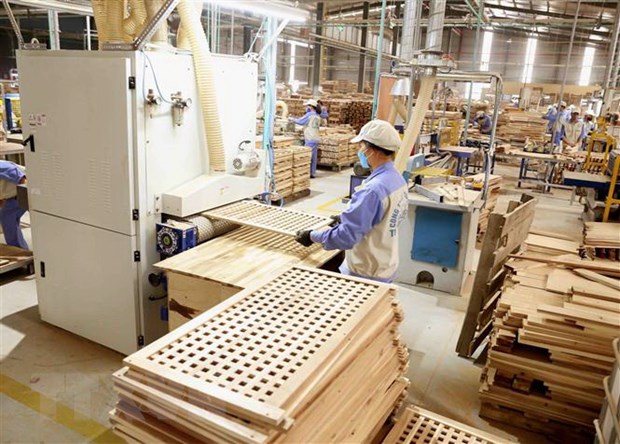 Economy
Economy


|
| Workers at Woodsland Joint Stock Company in the northern province of Tuyên Quang processing wood products for export to the EU. — VNA/VNS Photo |
HÀ NỘI — Despite many difficulties, the export of wood and forest products still reached the target of US$16.9 billion last year. Continuing this momentum, the industry has set an export turnover target of $17.5 billion this year.
Trần Thanh Bình from the Import and Export Department, Ministry of Industry and Trade, said the wood industry, like all trade sectors, could not avoid difficulties.
The reason is that the COVID-19 pandemic, the political situation and the high inflation coming from the US and EU major markets make it difficult for businesses to sign and fulfil orders.
The common difficulty of wood industry enterprises is high input costs and rising prices, which reduces the competitiveness of goods, including timber.
Strong fluctuations in the financial and monetary market also make wood production lose its competitive advantage.
Rapidly rising interest rates lead to high capital costs and the risk of disruption to the supply of raw materials and the value chain for the wood industry.
One of the critical drivers of exports is the expansion of exports in China, Japan and South Korea.
The US, Japan, China, EU and South Korea accounted for the total export value estimated at nearly $15.5 billion, accounting for 91 per cent of the export value of forest products, said the general secretary of the Việt Nam Timber and Forest Product Association Ngô Sỹ Hoài admitted.
In the opposite direction, the import value of wood and wood products was estimated at $2.8 billion last year, up 4 per cent compared to 2021.
The industry has a trade surplus of about $14.1 billion, up 6.5 per cent year-on-year.
The industry sets a positive target, with export turnover reaching $17.5 billion this year.
The growth rate of forestry production value is from 5 to 5.5 per cent. The forest cover rate remained stable at 42 per cent.
Concentrated afforestation will be 245,000 hectares, 140 million scattered trees will be planted, the output of harvested forest timber will be 22 million cubic metres, and the revenue from forest environmental services will be about VNĐ3 trillion (US$127 million).
Dealing with trade remedy lawsuits
Việt Nam is integrating very deeply with the free trade process through many trade agreements. Therefore, trade competition will become increasingly fierce; many countries apply self-defence measures.
Hoài explained that the wood industry has been facing anti-dumping lawsuits.
The country has over 6,000 small and medium enterprises, of which about 3,000 enterprises participate in the global supply chain.
Hoài emphasised the need to prepare well in two stages to respond well to trade defence cases.
The first is the pre-suit; before signing a commercial contract and preparing the shipment of wooden furniture for export, enterprises must listen and equip the best tools.
Enterprises needed to apply modern accounting software so that when there is a problem, it could provide proof, invoices and documents to prove business transparency.
Next comes dealing with the major market lawsuits that initiated the investigation.
"Vietnamese businesses are weak in knowledge of international law, foreign languages, and informatics," he said.
Strengthening corporate capacity management was essential, which included investing in knowledge, technology and people.
In addition, the role of each local timber association, the Việt Nam Timber Association, and the authorities must be enhanced, timely warnings to businesses must be increased, and training courses for businesses on trade defence skills, criticism, and record-keeping must be organised. — VNS




